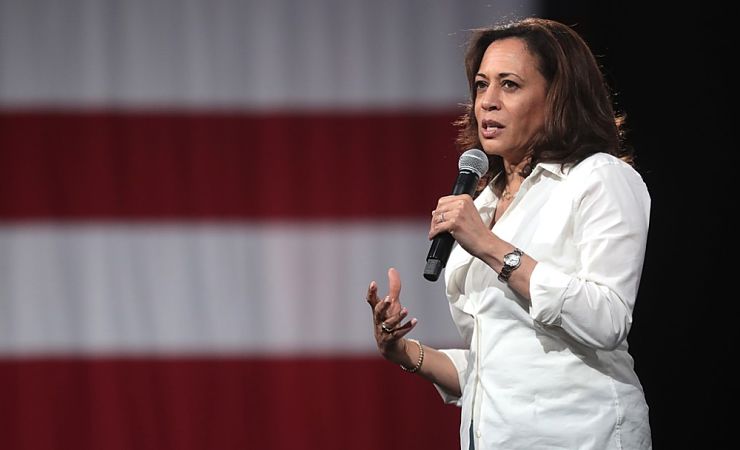‘Are We There Yet?’ Jane Hall Looks at Women in American Political Ecosystem

The 2020 elections marked a turning point for women in politics and the media—from the history-making election of Kamala Harris as vice president to the record-breaking 141 women, including 51 women of color, who were elected to Congress. Yet challenges remain, both in terms of media coverage of women in politics—and the treatment and representation of female political journalists of color and overall. That’s why we called a recent forum at American University “Are We There Yet? Progress and Challenges for Women in Politics and Media, 2020 and Beyond.” “Are we there yet?”—that line from passengers on a long car trip—says that we’ve come a long way, and there’s a ways to go.
April Ryan, White House correspondent for the Grio and CNN analyst, spoke personally at the event about “becoming the story” after former president Donald Trump berated her as a “loser” and “nasty” and refused to answer her questions about possible voter suppression and other topics. As noted in interviews with journalists for Politics and the Media: Intersections and New Directions, Ryan was one of several female journalists of color, including Yamiche Alcindor of PBS, Cecilia Vega of ABC and Abby Phillip of CNN, who were denigrated by President Trump in ways that many media critics found racist and sexist.
“I was targeted for asking questions about an underserved community,” said Ryan, who has covered five U.S. presidents in 24 years on the beat.“ My thought on journalism is that we’re supposed to be paint on the wall—you’re not supposed to notice us. The unfortunate thing was that I became part of the story.”
At the same time, Ryan said, “Any question can go there—I’m asking questions now. That document that has the First Amendment in it? I’m part of that. The Founding Fathers didn’t imagine an April Ryan—but I’m holding tight to that.”
According to a 2017 report from the Women’s Media Center, women represented two-thirds of journalism and communications graduates, but men were producing 63 percent of all news coverage. Despite the considerable gains in recent years by women and people of color in both media and politics, media organizations today are not keeping up with the increasing diversity of the U.S., especially in terms of management and high-profile positions.
Political reporting is still primarily male—and white male. But that is changing as more younger female journalists are becoming political reporters. And with issues of gender and race front-and-center in the 2016, 2018 and 2020 elections and beyond, there has been more reporting and analysis , often by female journalists, on the roles of gender. race and intersectionality in these campaigns and in the country overall.
TV, however, remains a place where women in politics can be called “strident” and told they need to smile more by pundits during a presidential debate—or “mainsplained” and ignored by their political opponents onstage. And, regrettably, online, misogyny and hate against both prominent female journalists and prominent female politicians has multiplied. Kamala Harris and other women of color have been especially targeted.
In terms of media coverage of female candidates, we are, generally, past the most sexist descriptions of women, including a focus on their personal appearance, their clothing and their family and marital status rather than on their record and their proposals. As we know from many studies, such focus undermines voters’ perceptions of female candidates’ viability and their capacity to lead. Yet, according to a study of some 1,400 news stories in major publications in 2019, male candidates received more attention to their proposals than female candidates, while the women were much more likely than the men to be critiqued personally and negatively.
In the 2020 presidential primaries among Democrats, the field was historically diverse, with a record six women running to be the first woman president of the U.S. The fact that the list included four U.S. senators—Kirsten Gillibrand, Kamala Harris, Amy Klobuchar, and Elizabeth Warren—along with Hawaii representative and military veteran Tulsi Gabbard and author Marianne Williamson– shows the results of having more women in the political pipeline for running for office.
There were also gains in 2020 by women in state legislative office. Republicans moved successfully to elect more Republican women to Congress. And the news media highlighted the role of Black voters and Black female leaders, including Stacey Abrams, as Joe Biden considered potential vice-presidential candidates.
Media coverage of Kamala Harris’s nomination and election focused on the historic “firsts” her election represented. All of these changes signify great progress. Now it’s time to see how Harris’s role is emerging, in policy and politics as well as media coverage. One question that is already being raised is whether Harris’ portfolio as vice president—which includes immigration at the U.S-Mexico border–is associating her with the Biden administration’s controversial handling of the crisis over thousands of Haitian migrants living in tents there, with many being deported. When women break the glass ceiling to achieve positions of power at a time of crisis, in business or in politics, they are sometimes described as being inadvertently driven “over a glass cliff” by being handed highly difficult or even impossible tasks.
There are several recent and upcoming elections where women are no longer running as the “first” and “only.” The Boston mayoral race with City Councilor Michelle Wu and City Councilor Annissa Essaibi George running against each other is just one example. And yet the U.S. presidency remains a highly gendered space, in politics and in media coverage. When Elizabeth Warren, an early front-runner for the nomination, withdrew in a race that Democratic voters said hinged on “electability” and who was the best bet to defeat Donald Trump, some Warren supporters and media critics wondered how and whether she had been hurt by comparisons to her as “another” Hillary Clinton. There were questions about whether Warren, with her seemingly Hillary-like experience and specific proposals, was “likeable” enough. “Likeability” – which reflects some deep-seated cultural attitudes about women in positions of power and authority–is still a barrier for women running for office. Research among voters in focus groups has indicated that voters will vote for a male candidate they consider unlikeable but qualified; so far, women candidates appear to need to be seen as both.






























































































